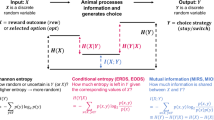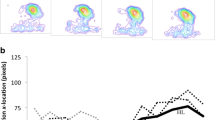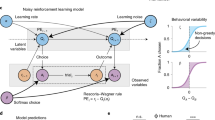Abstract
The relationship between behavioral variability and reward expectation has been examined in recent years. This relationship is predictive: when an animal has a low expectation of reinforcement for a particular behavioral set, they engage in high levels of variability in their actions. We conducted two experiments to further investigate this relationship using a novel measure of behavioral variability. In Experiment 1, two groups of rats were trained to travel through a column maze, with many possible reinforced pathways, to receive either their maintenance diet (i.e., chow) or a highly palatable sugary reward (cereal). We hypothesized that animals trained with a maintenance-diet food source (chow) would demonstrate more variation in the pathways taken to the goal location than those animals trained with the highly palatable alternative. In Experiment 2, all rats were trained to travel through the maze to receive alternating outcomes of chow or cereal in a within-subjects design. Results from both experiments indicated that rats emitted greater variability in paths taken to the goal when the reinforcer was the maintenance chow. These results corroborate the relationship between reward and behavioral variability in a new behavioral measure.





Similar content being viewed by others
Notes
It is important to note here the relevant contrast between respondent and operant variability in behavior. Increased variability can be generated in situations where the animal is explicitly trained to perform variably in order to obtain reward (e.g., Page and Neuringer 1985; Pryor et al. 1969); such a task engenders operant variability and reinforces variability itself as an operant dimension of behavior, much like an experimenter might reinforce the force or rate of a particular response. Respondent variability, on the other hand, is generated by an animal’s expectation of the delivery of a relevant outcome—in other words, variability is controlled by the Pavlovian relationship between stimuli and subsequent outcomes.
There is a vast literature indicating the powerful motivational qualities of sweet outcomes. Research has demonstrated that rat pups as young as 6 days of age are attracted to sweetness by the elicitation of consummatory responses to solutions of sucrose, lactose, and saccharin (Hall and Bryan 1981; Jacobs 1964; Vigorito and Sclafani 1980). When presented with polycose and sucrose solutions, 9 days old rat pups displayed more consummatory behavior compared to when they were presented with water (Sclafani 1991a). Researchers have found that both appetitive and consummatory responding in rats increases with increasing concentration of sugar in solution (e.g., Collier and Willis 1961; Davis 1973; Schwartz and Grill 1984).
References
Antonitis J (1951) Response variability in the white rat during conditioning, extinction, and reconditioning. J Exp Psychol 42:273–281
Balleine BW, Dickinson A (1998) The role of incentive learning in instrumental outcome revaluation by sensory-specific satiety. Anim Learn Behav 26:46–59
Balsam PD, Deich JD, Ohyama T, Stokes PD (1998) Origins of new behavior. In: O’Donohue W (ed) Learning and behavior therapy. Allyn & Bacon, Boston, pp 403–420
Berridge KC (2001) Reward learning: reinforcement, incentives, and expectations. In: Medin DL (ed) The psychology of learning and motivation. Academic, New York, pp 223–278
Biedermann T, Garlick D, Blaisdell AP (2012) Food choice in the laboratory pigeon. Behav Process 91:129–132
Cohen J (1988) Statistical power analysis for the behavioral sciences. Lawrence Erlbaum, New York
Collier G, Willis FN (1961) Deprivation and reinforcement. J Exp Psychol 62:377–384
Cousineau D (2005) Confidence intervals in within-subject designs: a simpler solution to Loftus and Masson’s method. Tutor Quant Meth Psychol 1:42–45
Covarrubias P, Aparicio CF (2007) Effects of reinforcer quality and step size on rats’ performance under progressive ratio schedules. Behav Process 78:246–252
Dashiell JF (1930) Direction orientation in maze running by the white rat. Comp Psychol Monog 7:72
Davis JD (1973) The effectiveness of some sugars in stimulating licking behavior in the rat. Physiol Behav 11:39–45
Denney J, Neuringer A (1998) Behavioral variability is controlled by discriminative stimuli. Anim Learn Behav 26:154–162
Eckerman DA, Lanson RN (1969) Variability of response location for pigeons responding under continuous reinforcement, intermittent reinforcement, and extinction. J Exp Anal Behav 27:165–178
Elizalde G, Sclafani A (1990) Fat appetite in rats: flavor preferences conditioned by nutritive and non-nutritive oil emulsions. Appetite 15:189–197
Epstein RE (1990) Generativity theory and creativity. In: Runco MA, Albert RS (eds) Theories of creativity. Sage, Newbury Park, pp 116–140
Gharib A, Derby S, Roberts S (2001) Timing and the control of variation. J Exp Psychol Anim Behav Process 27:165–178
Gharib A, Gade C, Roberts S (2004) Control of variation by reward probability. J Exp Psychol Anim Behav Process 30:271–282
Hall WG, Bryan TE (1981) The ontogeny of feeding rats: IV. Taste development as measured by intake and behavioral responses to oral infusions of sucrose and quinine. J Comp Physiol Psych 95:240–251
Jacobs HL (1964) Observations on the ontogeny of saccharine preference in the neonate rat. Psychon Sci 1:105–106
Jensen G, Stokes PD, Paterniti A, Balsam PD (2014) Unexpected downshifts in reward magnitude induce variation in human behavior. Psychon B Rev 21:436–444
Leising KJ, Ruprecht CM, Stahlman WD (2014) Modulation of variation by response-reward spatial proximity. Int J Comp Psychol 27:326–337
Neuringer A (2004) Reinforced variability in animals and people: implications for adaptive action. Am Psychol 59:891–906
Neuringer A, Kornell N, Olufs M (2001) Stability and variability in extinction. J Exp Psychol 27:79–94
Page S, Neuringer A (1985) Variability is an operant. J Exp Psychol Anim Behav Process 11:429–452
Pryor KW, Haag R, O’Reilly J (1969) The creative porpoise: training for novel behavior. J Exp Anal Behav 12:653–661
Roberts S, Gharib A (2006) Variation of bar-press duration: where do new responses come from? Behav Process 72:215–223
Schwartz GJ, Grill HJ (1984) Relationship between taste reactivity and intake in the neurologically intact rat. Chem Sens 9:249–272
Sclafani A (1991a) The hedonics of sugar and starch. In: Bolles RC (ed) The hedonics of taste. Psychology Press, Hillsdale NJ, pp 59–87
Sclafani A (1991b) Conditioned food preferences. Bull Psychon Soc 29:256–260
Skinner BF (1945) The operational analysis of psychological terms. Psychol Rev 52:270–277
Stahlman WD, Blaisdell AP (2011a) The modulation of operant variation by the probability, magnitude, and delay of reinforcement. Learn Motiv 42:221–236
Stahlman WD, Blaisdell AP (2011b) Reward probability and the variability of foraging behavior in rats. Int J Comp Psychol 24:168–176
Stahlman WD, Roberts S, Blaisdell AP (2010a) Effect of reward probability on spatial and temporal variation. J Exp Psychol Anim Behav Process 36:77–91
Stahlman WD, Young ME, Blaisdell AP (2010b) Response variability in pigeons in a Pavlovian task. Learn Behav 38:111–118
Stahlman WD, Leising KJ, Garlick D, Blaisdell AP (2013) There is room for conditioning in the creative process: associative learning and the control of behavioral variability. In: Vartanian O, Bristol A, Kaufman J (eds) The neuroscience of creativity. MIT Press, Cambridge, pp 45–67
Tolman EC (1932) Purposive behavior in animals and men. University of California Press, California
Tolman EC, Honzik CH (1930a) ‘Insight’ in rats. Univ Cali Publ Psychol 4:215–232
Tolman EC, Honzik CH (1930b) Introduction and removal of reward, and maze performance in rats. Univ Cali Publ Psychol 4:257–275
Tumer EC, Brainard MS (2007) Performance variability enables adaptive plasticity of crystallized adult birdsong. Nature 450:1240–1244
Vigorito M, Sclafani A (1980) Ontogeny of polycose and sucrose appetite in neonate rats. Dev Psychobiol 21:457–465
Wu HG, Miyamoto YR, Castro LNG, Olveczky BP, Smith MA (2014) Temporal structure of motor variability is dynamically regulated and predicts motor learning ability. Nat Neurosci 17:312–321
Acknowledgments
Funding for this research was supported by the Department of Psychology at the University of Mary Washington. We thank members of the PSYC413 Seminar in Learning for their assistance in data collection. Experimental protocols followed relevant ethical guidelines and were approved by the University of Mary Washington’s Institutional Animal Care and Use Committee.
Author information
Authors and Affiliations
Corresponding author
Rights and permissions
About this article
Cite this article
Griffith, K.A., Farnsworth, E.M. & Stahlman, W.D. Reward expectation modulates variability in path choice in rats. Anim Cogn 18, 131–138 (2015). https://doi.org/10.1007/s10071-014-0784-6
Received:
Revised:
Accepted:
Published:
Issue Date:
DOI: https://doi.org/10.1007/s10071-014-0784-6




